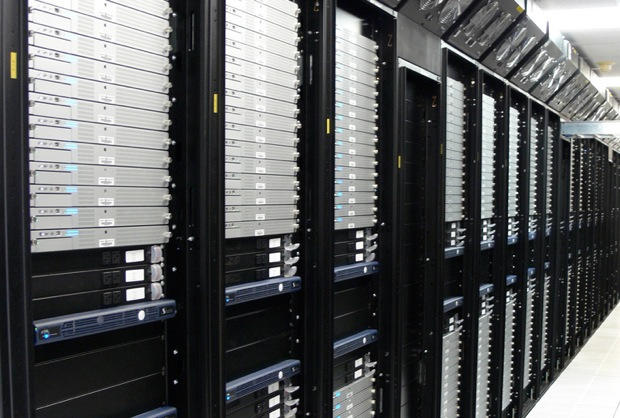Google’s Eric Schmidt “resigned” from Apple’s board because Chrome and Android were encroaching on Apple’s core business, or so Steve Jobs says.
But what if the opposite were true? What if Apple is encroaching on Google’s core business?
Later this month, Apple is expected to break ground on a massive new data center in Maiden, North Carolina.
In terms of size, Apple’s data center is as big as they come.
“Apple is planning about 500,000 square feet of data center space in a single building,” says Rich Miller, editor of Data Center Knowledge. “That would place it among the largest data centers in the world… This would qualify as a big-ass data center.”
Question is, what will Apple use it for? Apple’s plans are secret, of course, and some have speculated it’s to support Apple’s growing MobileMe business and online iTunes stores.
But Miller says the size of the data center hints at something else. Companies building centers this big are getting into cloud computing. Running apps in the cloud requires massive infrastructure: Google-size infrastructure.
“The companies that are building the biggest data centers tend to also have the biggest cloud ambitions,” says Miller.
The full interview with Miller after the jump:
CoM: First, any idea why Apple is building this new data center?
Miller: Apple has said very little about the North Carolina facility, beyond the fact that it will serve as the company’s East coast data hub. Apple also has a West coast data center facility in Newark, Calif. Local officials I’ve spoken with say they believe the space is primarily to support Mobile Me and digital content for the iTunes store. The most interesting question is whether Apple needs a much larger facility to support growth in its existing services, or is scaling up capacity for future offerings.
CoM: Could Apple be building it for cloud computing apps — cloud versions of its iLife apps for example?
Miller: One of the leading theories about the size of the NC project is that Apple is planning future cloud computing services that will require lots of data center storage. Cloud computing is a hot trend, and I’d be surprised if Apple isn’t thinking hard – and thinking differently – about cloud computing. Many cloud enthusiasts say that cloud computing will eliminate the need for data centers. In reality, the only thing will change is the owner of the building. All the applications and data that are moving into the cloud will live on servers in brick-and-mortar data centers. The companies that are building the biggest data centers tend to also have the biggest cloud ambitions.
CoM: How big is Apple’s new North Carolina data center — big, small, medium?
Miller: The early site plans indicate Apple is planning about 500,000 square feet of data center space in a single building. That would place it among the largest data centers in the world. For comparison purposes, Apple’s existing data center in Newark, Calif. is a little more than 100,000 square feet. Most new stand-alone enterprise data centers are in the range of 100,000 to 200,000 square feet. So this would qualify as a big-ass data center.
CoM: What’s it comparable to? Do you know of any specific examples?
Miller: In the past several years we’ve seen a handful of new facilities that are redefining the scope of modern data centers. These include Microsoft’s new facility in Chicago, the SuperNAP in Las Vegas and the Phoenix ONE colocation center in Phoenix. All of these facilities house at least 400,000 square feet of space. These data centers are designed to support an enormous volume of data, and reflect the acceleration of the transition to a digital economy. All those digital assets – email, images, video and now virtual machines – drive demand for more and larger data centers.
CoM: Why did Apple chose NC? Are there particularly big pipes in NC? A big powerplant nearby?
Miller: The choice of rural North Carolina suggests that the bottom line for Apple is cost, rather than connectivity. The site in Maiden, NC is not far from a large data center by Google, which usually chases cheap power and tax incentives. Power from Duke Energy is about 4 to 5 cents per kilowatt hour, compared to 7 to 12 cents in California. The company also maximized its incentives by pitting Virginia and North Carolina against one another in trying to wring the best tax incentives out of both states (a popular strategy in data center site location).
Some large companies use distributed data centers to manage their latency and content delivery costs. That may be part of Apple’s thinking, since they’re a major customer for CDNs (I believe they use both Akamai and Limelight Networks). Facebook cited latency to Europe as a key factor in its decision to add data centers in Virginia. Before that, MySpace added a data center in Los Angeles to reduce its reliance on CDNs. But in both cases, those companies sought out Internet hubs where they could connect with dozens of other networks to manage their Internet traffic. You don’t get that in rural North Carolina, so Apple seems more focused on cost and scale than on connectivity – which again would suggest a cloud focus.


